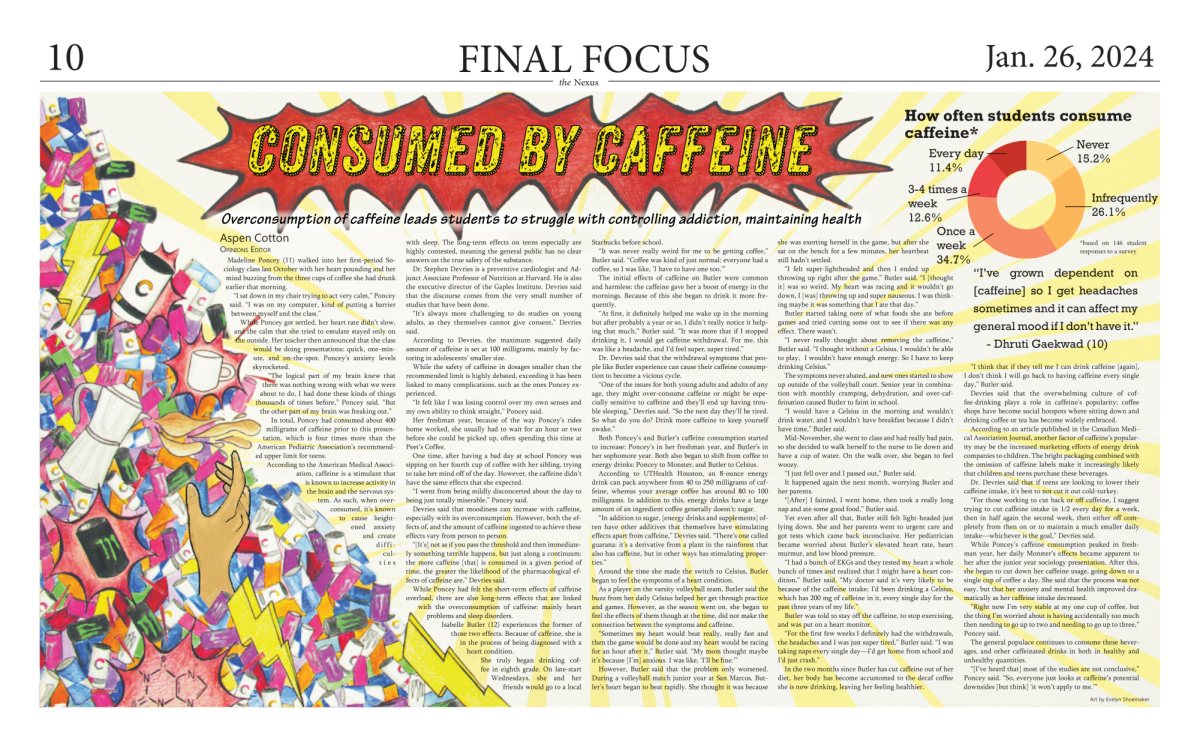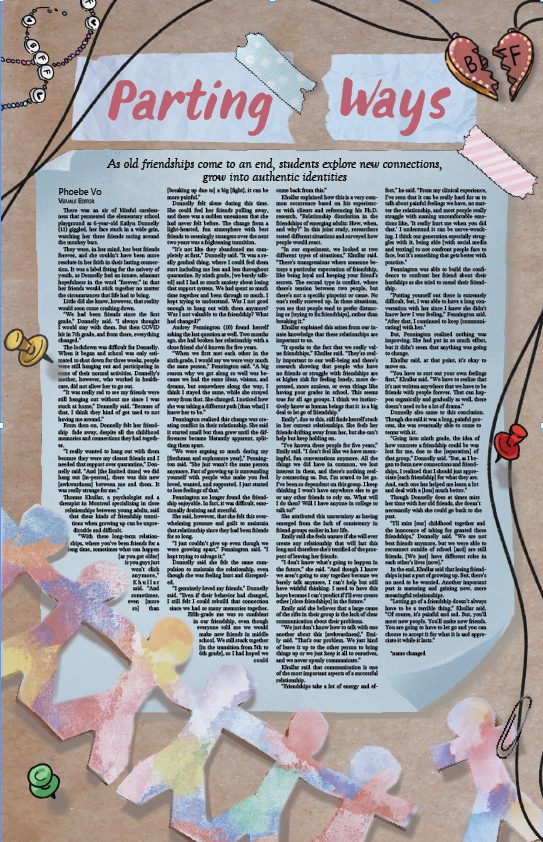With an upcoming calculus midterm and two essays due for Humanities, Zoey Espiritu (10) knew she needed to lock in and get all of her work done on time. Although the sense of urgency to get things done built up as due dates crept closer, Espiritu found her phone drawing her attention away like a magnet, making staying on task for long periods of time nearly impossible.
“When I’m doing homework, I tell myself I can take a break,” Espiritu said. “The break is supposed to be five minutes, but because it’s so easy [to watch reels],, I just watch one more, then another, then another. Before I know it, it’s been too long, and then I don’t get anything done.”
The rise of short-form social media platforms, like TikTok or Instagram reels, is taking over many teens’ lives. Between January 2018 and July 2020, TikTok had a 1,157.76% increase in the number of worldwide users.
Kaitlyn Burnell, a research assistant professor at the Winston National Center on Technology Use, Brain, and Psychological Development, has a Ph.D. in Psychological Sciences. She said that the quick customized content of these platforms ensures that the videos are entertaining and even addicting, making it hard for students to focus on other tasks.
“Social media apps are designed to maximize user engagement,” Burnell said. “Algorithms are used to determine what types of content users find most interesting and then recommend content that can prolong use. Endless scrolling features can also continue user engagement, as there is no clear “endpoint” to use. Users can continue to be exposed to new content if they continue to scroll.”
When there is an infinite amount of content on these platforms, teenagers can end up spending hours watching hundreds of 15-second videos if they don’t stop themselves.
Dr. Nia Williams, a lecturer specializing in child development at the School of Education and Human Development at Bangor University, said that social media can have a big impact on the attention span of students, reducing their ability to focus.
“If children are used to short-form social media, they might be trying to find stimulation in the same way when they are trying to learn, which could, in turn, impact their ability in the classroom.”
Chaewon Chon (10) often experiences this problem when she does schoolwork.
“I do work for 15 minutes and then I pick up my phone every five minutes to see if I have any notifications,” Chon said. “Or, when I’m bored, I open Instagram and then I keep scrolling and get stuck.”
Psychological Impacts
This constant mindless scrolling has been found to make it difficult for individuals to focus for extended durations.
According to a 2021 article in the Frontiers in Psychology journal by Yinbo Liu titled “Perceived Stress and Short-Form Video Application Addiction: A Moderated Mediation Model,” this addiction is caused by two main things: perceived stress and positive intermittent reinforcement. Perceived stress is a situation that seems threatening or demanding, like a long and difficult assignment or a confusing lecture.
Our minds typically adapt to this challenging situation by resorting to the use of short-form content. When this process is repeated again and again, it leads to the emergence of addiction symptoms.
Tyler Patay (12) found himself constantly on his phone when eating meals, before sleeping, or just when there was time to pass as a way to relieve some of his stress.
“When you open your phone, you just feel more relaxed,” Patay said. “If you get a text on your phone, you feel an itch to go and look at it and then once you open [your] phone, you feel less stressed or less worried.”
According to Burnell, the modern-day “solution” for teens to relieve themselves of small stressors is to go on their phones and scroll through Instagram reels or YouTube Shorts.
“There is a decades-old theory called mood management theory that suggests that people gravitate towards various forms of media as a way to manage their mood,” Burnell said. “For example, if someone is feeling down, they may watch a comedy to brighten their mood. This can also occur with new media like social media, where people may turn to social media when they are feeling down in order to try to make themselves feel better. [For example], going to a supportive online community [or] watching funny videos.”
Williams said that this repeated social media use has a large influence on how human brains develop.
“Whatever happens within our environment, including social media, can have a big impact on our brains and therefore how we live our lives,” Williams said.
As a freshman, Alex Kun (9) said he has felt a drastic change in his attention span since he stopped using social media as much, even to the point where it affected his academics
“Recently, I had to study for my chemistry finals,” he said. “After only a few minutes, my phone kept vibrating, and I found it very hard to concentrate. Initially, I was able to resist the temptation to check it, but someone sent me a reel. I watched it and replied to them, but the next one was just one swipe away. What I initially thought would be a short 5-minute break quickly turned into a long distraction, and when I got back to work, it was very hard to focus the same amount.”
Not only is short-form content distracting, but it is also extremely difficult to stop watching. According to Liu’s study, this is due to positive intermittent reinforcement.
While stressors make people drawn to their phones, Liu’s research finds that positive intermittent reinforcement keeps them watching. It is a key player in the success of short-form video apps. If viewers come across an uninteresting video, the belief that the next one will be better keeps them scrolling.
Strategic Marketing Features
Rather than developing algorithms that enhance our well-being, social media corporations design algorithms that encourage prolonged screen engagement.
In his book “Stolen Focus,” Johann Hari states that a major player in the time-devouring nature of short-form content applications is the use of the endless scroll. Before the endless scroll was invented, internet users would have to take the time to click a button and load the next page. This deliberate decision left a moment for individuals to pause and ask themselves, “Do I really want to keep looking at this?”
Hari found that this seemingly insignificant added feature was found to increase the time spent on social media apps like Twitter by over 50%. The added time spent online due to the addition of the endless scroll summed up to a total of more than 200,000 human lifetimes spent scrolling online per day.
Burnell said that social media platforms try their best to get users to stay on the app for long periods of time.
“There are features of social media that can increase time spent engaging with content, such as autoplay features and recommended content,” she said. “This may result in more time spent watching short-form social media than originally intended.”
Kun found that these features made it extremely easy for him to lose track of time.
“The downside of [watching Reels] is that not only does it make you lose your attention span, but it also drains a lot of time,” he said. “You go home and you tell yourself you’re going to take a 10-minute break, and then you end up scrolling for an hour and your whole afternoon is gone. You can’t get stuff done.”
For social media companies, each extra minute spent on their app means more money in their pockets. Their business model is to grab people’s attention away from other things and take away as much time as possible. According to Burnell, features such as the endless scroll and personalized content are deliberately designed by experts in their field to distract viewers and make sure they continue staring at their screen, generating revenue. For this reason, these corporations see a user putting down their phone as losing money.
Kun experienced difficulties as a result of these meticulously crafted features.
“You tell yourself that you’re only going to [watch] for 10 minutes, 15 minutes, and then all of a sudden, all the time is gone,” he said. “There’s nothing that the app gives to help [you] stop. You have to stop yourself, which is very hard on its own.”
Constantly getting pulled into this endless scroll makes it hard for people to be without their phones. Chon recognized the extent of her dependence on her cell phone when she cracked her phone and couldn’t use it for a day while it was getting repaired.
“I couldn’t focus because I [felt like I] needed to do something,” she said. “I can’t just listen to my teacher’s lecture [without having something else to do]. And so I was just sitting there, like, what do I do?”
After being extremely bored for her first two periods, Chon noticed that she could be more productive without her phone, as it was damaging her ability to focus. When she had her phone with her, she was constantly distracted by it and couldn’t concentrate on the lesson.
“I didn’t know how I was going to get through the rest of the day, but then after the third period, I was like, well, I can’t really do anything about not having my phone,” she said. “So, I realized that if I just focus, I can actually not have to stress about school because everything [in class] made sense.”
What we can do
Even though it can be difficult to put down your phone, Burnell advises that the first step is to be conscious of how you are using your social media.
“Healthy social media use starts with a reflection of one’s own use,” she said. “Curate your social media use so that you are focusing on social media that makes you feel good, and reduce social media use that makes you feel bad.”
In order to limit social media use, Burnell suggests that people start to notice how social media influences their persona around people they know.
“Think about how social media may affect your face-to-face relationships too and how it may affect other parts of your life,” Burnell said. “You may want to instill the norm among your friends and family to put your phones away when face-to-face. You also may want to put your phone away right before bed or when you are doing your homework.”
Some students have been taking creative measures to keep themselves from being distracted. To limit his screen time, Patay uses a special function in the settings app.
“I turn my phone on black and white by going into settings. There’s a color filter and you just turn off the color.”
This black-and-white function makes looking at his phone less enjoyable.
“It’s not really appealing [when] you look at your phone, you don’t feel that wave [of relaxation] wash over you,” Patay said.
Espiritu said that spending less time on her phone allows her to feel more present. When she was on a trip to Europe, she had to go a week without data on her phone because of the extra cost.
“Initially I was really bored, but as I got used to it, I got to interact with the people around me more rather than just using social media,” she said. “I [also] got to admire the scenery when we were on the long bus ride. So, I think it was better overall, but initially, I was very annoyed.”
Espiritu said that putting down her phone has helped open her up to new experiences.
“When you use your phone, you’re more confined to the screen and the small space,” she said. “[When you put it down], you realize how big the world around you is. ”












![Alexander McAllister (10) [third from the left] practices with his rowing team at Mission Bay, Feb. 8. McAllister has learned to work in unison with others on the water.](https://wvnexus.org/wp-content/uploads/2024/02/alex-rowing-1-1200x837.jpg)


